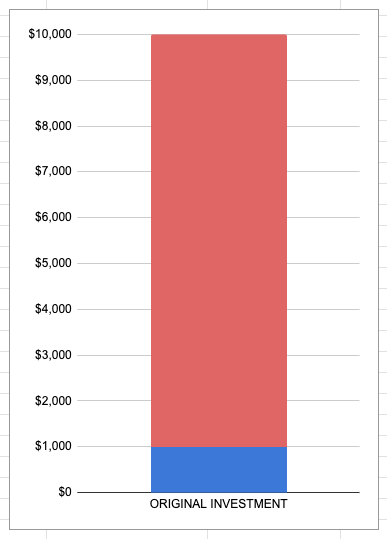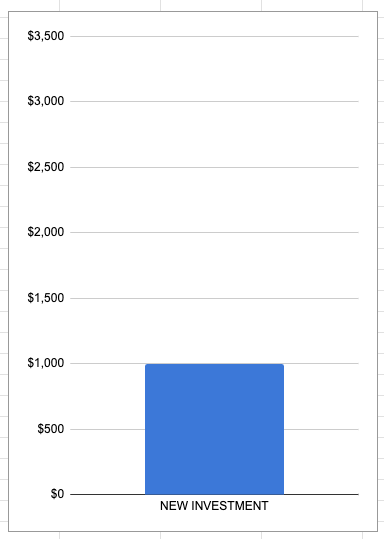- The Moneycessity Newsletter
- Posts
- How to Recover from a Huge STOCK LOSS
How to Recover from a Huge STOCK LOSS
How to reduce financial risk and potentially benefit from failed investments? I am sharing a personal story about losing significant money on a certain SPAC and the underutilized, easy, and effective strategy for managing investment losses. I will also share specific scenarios where this approach works well and examine situations where it may not.
How do you make the most out of an investment that has crashed?
I have had many interesting wins and also a fair share of losses over the past 10 years of investing, with the most recent one being Bill Ackman’s SPAC.
They had a great acquisition partner, Universal Music Group, queued up. But the SEC shot down the deal. And then, there was a lawsuit. Before I knew it, they failed to have an acquisition partner and money was returned to shareholders. And I lost.
If you’re like me and you like to have at least a portion of your portfolio set aside for investing in individual stocks for a little bit more risk and a little bit more reward, you’re going to have some losers.
There’s no way to avoid it.
Sometimes new information will come out that you could not anticipate. The stock dips, falls, and crashes and now where do you go from here?
Do you sell?
Do you double down and buy a lot more?
Do you just put it in the corner of your portfolio and never look at it again?
Whatever you do, inaction is a decision and it has never worked for me.
Across my failures, I have deployed a system to lock in insane gains on what’s left of my investment, redeploy that capital, and then have a plan for how to not lose money on a stock in the future.
On the go? Watch the video HERE.

What to Do with a DEAD Stock?
Step 1: Mindset
There are two situations where I found the system works incredibly well:
Situation 1: There is new information that comes out causing the stock to crash, and now I’m in a position where if I had that money again, knowing the information I know now, I wouldn’t invest in it again.
Situation 2: The stock crashes but I think it is going to go back up in the next several months or years. I am confident there will not be a huge increase within the next month.
This graph shows a $10,000 investment where I lose 90%. That’s a $9,000 loss, which is shown by the red portion of the graph. The blue portion is what’s left — $1,000.

Investing gain and loss illustration by author
The mistaken mindset that I’ve been guilty of is I keep seeing the old investment in my mind. I’m like “Oh, I got to get back to that old investment.”

Investing gain and loss illustration by author
But in reality, I have found much more success by just viewing the $1,000 as my new position, forgetting about the $9,000.
How do I go from here in the best way possible?

Investing gain and loss illustration by author
Step 2: Execution
Let’s think about the first situation.
Situation 1
Maybe Elon Musk moves to Mars and the stock tanks. I don’t want to be invested in Tesla anymore without its superstar CEO. There are two ways to react to this news:
Option 1: I could be stubborn and not want to admit that I’m wrong. Maybe I’ll just put it in the corner of my portfolio. The reason that has not worked for me is I have to think about what’s left as a new investment that I have to do the best possible thing with.
Option 2: If I just cut ties and sell that stock, then I have created a capital loss which gives me a tax benefit.
If I can offset another capital gain with that $9,000 loss, and I’m in the 12% tax bracket, then I would get a $1,080 tax benefit. When you compare that to what your current position is, which is just $1,000, that is over a 100% gain. I just 2Xed that remaining investment by selling it.

($1,080 + $1,000) / $1,000 = 108% “Gain” from Tax Loss Harvesting
If I’m in the 22% tax bracket, I’m making $1,980. That’s a 3X gain nearly just by selling the stock.

($1,980 + $1,000) / $1,000 = 198% “Gain” from Tax Loss Harvesting
If I don’t believe in that stock anymore, what are the chances that it’s going to 3x in a short amount of time?
Unlikely.
Let’s talk about the second situation where this system works incredibly well.
Situation 2
Elon is going to Mars but he tells everybody he will come back someday. The market doesn’t know when and thinks he could die on Mars so the stock price drops. But I believe he’ll be back so I want to continue to hold the stock.
If I still sell that stock, take advantage of the tax loss harvest then buy it back in 1 month as long as that stock didn’t 2X or 3X, then I will be in a better position.
And yes, for tax loss harvesting, you have to sell and then buy back after a month. If you just sell and buy back in 1 day, tax loss harvest won’t work. They will call it a wash sale and you will not get your tax credit.
The average monthly return of the S&P 500 is less than 1%. When you’re looking at what position you have now, being able to guarantee a 2X or 3X gain in one month is insane.

Investing gain and loss illustration by author
So this system will work as long as I do not have a strong reason to think that it’s going to pop off in less than a month.
Of course, there are some situations where I WOULD NOT use this system.
Situation 1
As a rule of thumb, you need some capital gains to offset the capital losses.
If I lost $9,000 and didn’t have $9,000 in gains that year, I would think twice. Now, I can use $3,000 each year to offset my income. In this case, if I’m comfortable with spreading those capital losses out over 3 years to offset my income, then maybe it’s still a good idea.
But if I don’t have income or a capital gain yet for that year, maybe it doesn’t make sense to utilize that capital loss at that time. I might want to wait until I have a capital gain to offset the loss.
Situation 2
The next situation where I would not necessarily want to use this strategy is if my investments are in a tax-sheltered account.
If I have Tesla in my HSA, IRA, or 401K, I do not get to benefit from the capital losses. For tax-sheltered accounts, I don’t get taxed on the capital gains and I can’t benefit from the losses either.
Situation 3
I wouldn’t necessarily use this strategy is if I was very confident that the stock would recover within 1 month and the market was overreacting.
Back to the Elon Musk example, maybe it’s no big deal for Elon Musk to go to Mars and the market has no business dropping by 90% because of that. I am confident that Tesla will bounce back up in less than a month.
I mean, would you invest in Tesla if you found out Elon Musk was going to Mars?
Eh, I might.
Step 3: Planning
The next step in my system is to reduce the chances that I’m even in that position to begin with.
I do not want to put myself in a position where I have to make an important decision while I am in a compromised state of mind.
On one hand, I want to make a plan when I enter the position for what is the maximum pain that I’m willing to experience. I use stop-loss orders to stop myself from losing 90% of my investment.
On the other hand, I don’t want to ride a stock up to 100% but not do anything and miss the window altogether. I like to put in different limit sell orders for different levels of gains to lock in that profit.
At the same time, I also allocate a big portion of my nest egg in a safe dividend ETF like this one HERE where I share the method I use to find the best dividend ETFs.
Catch you on the flip side.

Reply